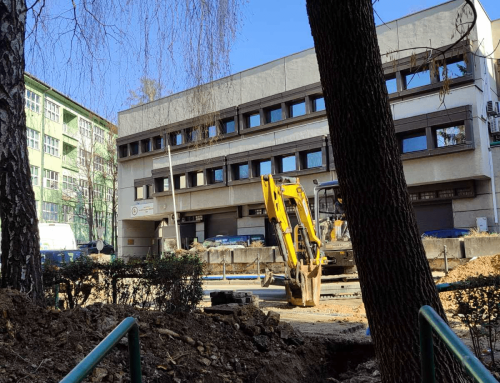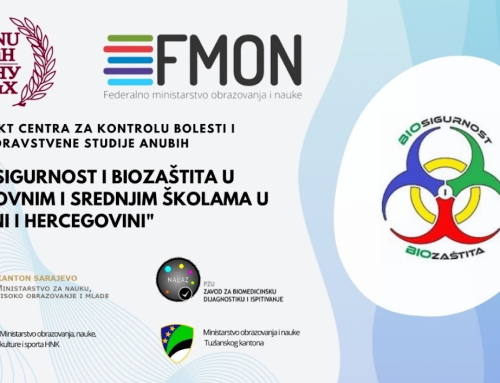Biofilm predstavlja zajednicu mikroorganizama koji su ireverzibilno povezani sa površinom, produciranjem ekstracelularne polimerne supstance (EPS), i pri tome pokazuju izmjenjene osobine (fenotip) u poređenju sa korespondirajućim planktonskim ćelijama.
U skladu s tim, biofilmovi se smatraju slijedećim velikim izazovom za mikrobiologe i kliničare, naročito uzimajući u obzir njihove visoke stope rezistentnosti prema antibioticima što ih čini izuzetno zahtjevnim za tretiranje.
Mr.sci. Monia Avdić

Formiranje biofilma odvija se u nekoliko uzastopnih faza. U prvoj fazi dolazi do inicijalnog transporta i reverzibilnog vezivanja bakterija za površinu na kojoj se nalaze adsorbovane organski i anorganski nutrijenti. Nakon toga slijedi lučenje EPS-a koji formira mostove između pojedinačnih ćelija, što rezultira ireverzibilnim vezanjem odnosno „cementiranjem“ ćelija za površinu. Posljednja faza u formiranju biofilma jeste kolonizacija površine. Za podlogu pričvršćene bakterije rastu i dijele se formirajući tako mikrokolonije, koje se smatraju osnovnim organizacionim jedinicama biofilmova. „Primarni kolonizator“ luči supstance koje privlače druge plantkonske batrerije iz okoline (sekundarna kolonizacija). Kompletirani biofilm kompleksne je arhitekture i građen je od bakterija smještenih u EPS obloženim mikrokolonijama između kojih se nalaze nešto rijeđi dijelovi matriksa u kojima su smješteni visoko permeabilni vodeni kanali koji služe za transport nutrijenata i otpadnih produkata.
Kolonizacija površina i naknadno formiranje biofilmova najbolje je izučena kod bakterija, iako su gljivice, alge, protozoe i virusi također izolovani iz biofilmova u industrijskom i medicinskom okruženju. Biofilmovi mogu nastati na skoro svim površinama u okolišu, bez obzira da li je riječ o prirodnim (biljke i životinja) ili sintetičkim materijalima (medicinski implantati i industrijske površine).
Kod ljudi bakterijski biofilmovi mogu imati zaštitnu ulogu. Npr. u crijevima komenzalne bakterije formiraju biofilmove koji su vezani za epitelne ćelije, formirajući tako barijeru koja spriječava prodor patogena. Zubni plak se sastoji od raznolikih bakterijskih biofilmova, a propadanje zuba nastaje kao rezultat proliferacije patogenih sojeva u istim. Iako su biofilmovi ubikvitarni u prirodi njihova signifikantnost u kliničkom okruženju je često podcijenjena. Danas biofilmovi predstavljau ozbiljan izvor infekcija, naročito kod imunokompromitiranih individua sa implantiranim medicinskim spravama (poput katetera). Ovo ima ozbiljne kliničke posljedice i uzrok je mnogih perzistentnih i hroničnih infekcija. Pri tome treba imati u vidu da se bakterijske ćelije unutar biofilma nalaze se u EPS-u koji im pruža zaštitu od odbrambenih mehanizama domaćina kao i od antimikrobnih sredstava. Infekcije uzrokovane formiranjem biofilmova često imaju ponavljajuće simptome sve dok se izvor infekcije ne odstrani hirurški. Kod oportunističkih patogena, poput Staphylococcus epidemidis, sposobnost formiranja biofilmova se smatra faktorom virulentnosti, te do tada komenzalne bakterije postaju ozbiljan izvor infekcije u bolničkom okruženju. Brojna istraživanja potvrdila su da su unutar biofilmova stope horizontalnog genskog transfera mnogo veće nego kod planktonskih bakterija. U biofilmu, horizontalnim genskim transferom, geni odgovorni za pojavu rezistentnosti na antibiotike mogu preći sa komenzalnih na patogene bakterije. Smatra se da je „zloglasna MRSA“ stekla mecA gen, koji je odgovorran za njenu rezistentnost na meticilin upravo horizontalnim genskim transferom.
U skladu s tim, biofilmovi se smatraju slijedećim velikim izazovom za mikrobiologe i kliničare, naročito uzimajući u obzir njihove visoke stope rezistentnosti prema antibioticima što ih čini izuzetno zahtjevnim za tretiranje.
Literatura
1. Donlan, R. M. (2002). Biofilms: microbial life on surfaces. Emerging infectious diseases, 8(9), 881-90.
2. Fux, C. A., Costerton, J. W., Stewart, P. S., & Stoodley, P. (2005). Survival strategies of infectious biofilms. Trends in microbiology, 13(1), 34-40.
3. Hall-Stoodley, L., Costerton, J. W., & Stoodley, P. (2004). Bacterial biofilms: from the natural environment to infectious diseases. Nature Reviews Microbiology, 2(2), 95-108.
4. Madsen, J. S., Burmølle, M., Hansen, L. H., & Sørensen, S. J. (2012). The interconnection between biofilm formation and horizontal gene transfer. FEMS Immunology & Medical Microbiology, 65(2), 183-195.
5. Stewart, P. S., & William Costerton, J. (2001). Antibiotic resistance of bacteria in biofilms. The Lancet, 358(9276), 135-138.
6. Tormo, M. Á., Knecht, E., Götz, F., Lasa, I., & Penadés, J. R. (2005). Bap-dependent biofilm formation by pathogenic species of Staphylococcus: evidence of horizontal gene transfer?. Microbiology, 151(7), 2465-2475.
Biofilms represent associations of microorganisms which are irreversibly connected to the surfaces by the production of a extracellular polymer substance (EPS) and at the same time show changed characteristics (phenotype), compared to the corresponding planktonic cells.
Accordingly biofilms are considered the next great challenge for microbiologists and clinicians especially taking into account their high rates of resistance towards antibiotics which makes them very difficult to treat.
Mr.sci. Monia Avdić
The „Gold Model“ for most microbiological examinations is the study of microorganisms in pure culture or the aqueous planktonic phase. However, the paradigm about planktonic bacterial cells does not reflect the real growth of bacteria in nature. Hence, during the last decade many studies were directed towards the understanding of bacterial growth in natural conditions. From these studies it is clear that many bacteria exist as part of a complex association attached to the surfaces and embedded in their own extracellular matrix. Today, such associations are more commonly known as biofilms. Biofilms represent associations of microorganisms which are irreversibly connected to the surfaces by the production of a extracellular polymer substance (EPS) and at the same time show changed characteristics (phenotype), compared to the corresponding planktonic cells. EPS is a highly dehydrated and chemically complex matrix which has the aim to store nutrients and at the same time can trap other microbes as well as non-cellular material like minerals, crystals and corrosion products. Inside a biofilm cells function coordinately as a cooperative consortium, in a way mimicking a multicellular organism. The process of developing this complex and highly differentiated association from single cells demands complex genetic regulation.
The formation of biofilms occurs in several consecutive phases. In the first phase an initial transport and reversible attachment of bacteria to the surface, with adsorbed organic and inorganic nutrients, takes place. Subsequently EPS gets secreted and it forms bridges between individual cells, which results in the irreversible attachment or „cementing“ of the cells to the surface. The last phase, in the formation of a biofilm, is the colonization of the surface. Bacteria, which are attached to the surface, grow and divide and by doing so create micro-colonies, which are regarded as the elemental organization units of biofilms. The “primary colonizer“ secrets substances which attract other planktonic bacteria that are found in the environment (secondary colonization). A completed biofilm has complex architecture and is made out of bacteria embedded in EPS coated micro-colonies, between which there are less dense parts of the matrix with permeable water channels that aid in the transport of nutrients and waste products.
The colonization of surfaces and subsequent formation of biofilms is best studied in bacteria, although fungi, algae, protozoa and viruses have been isolated from biofilms in the industrial and medical setting. Biofilms can form on almost all surfaces in the environment, irregardlessly weather the material is natural (plant and animal) or synthetic (medical indwelling device and industrial surface).
In humans biofilms can have a protective role. For example the gut commensal flora forms biofilms which are attached to epithelial cells, making a barrier which prevents the penetration of pathogens. Dental plaque is made out of different bacterial biofilms, but the decline of teeth is a consequence of proliferation of pathogenic strains in the same. Although biofilms are ubiquitary in nature, their significance in the clinical setting is often underestimated. Today biofilms represent a severe source of infection, especially in immunocompromised individuals with indwelling medical devices (like catheters). This has serious clinical consequences and is the cause of many persistent and chronic infections. Thereby one should have in mind that bacteria inside a biofilm are embedded inside EPS which provides them protection from the hosts immune response as well as antimicrobial remedies. Infections caused by biofilms often have recurring symptoms until the source of the infection is not removed surgically. In opportunistic pathogens, like Staphylococcus epidermidis, the ability to form biofilms is considered a factor of virulence and so commensal bacteria become a severe source of infection in the hospital environment. Today numerous studies confirmed that the rates of horizontal gene transfer are elevated in biofilms compared to planktonic bacteria. Inside biofilms horizontal gene transfer is responsible for the appearance of antibiotic resistance which can pass from commensal to pathogenic bacteria. It is considered that the “notorious MRSA” gained the mecA gene, which is responsible for the resistance to methicillin, through horizontal gene transfer.
Accordingly biofilms are considered the next great challenge for microbiologists and clinicians especially taking into account their high rates of resistance towards antibiotics which makes them very difficult to treat.
Literature
1. Donlan, R. M. (2002). Biofilms: microbial life on surfaces. Emerging infectious diseases, 8(9), 881-90.
2. Fux, C. A., Costerton, J. W., Stewart, P. S., & Stoodley, P. (2005). Survival strategies of infectious biofilms. Trends in microbiology, 13(1), 34-40.
3. Hall-Stoodley, L., Costerton, J. W., & Stoodley, P. (2004). Bacterial biofilms: from the natural environment to infectious diseases. Nature Reviews Microbiology, 2(2), 95-108.
4. Madsen, J. S., Burmølle, M., Hansen, L. H., & Sørensen, S. J. (2012). The interconnection between biofilm formation and horizontal gene transfer. FEMS Immunology & Medical Microbiology, 65(2), 183-195.
5. Stewart, P. S., & William Costerton, J. (2001). Antibiotic resistance of bacteria in biofilms. The Lancet, 358(9276), 135-138.
6. Tormo, M. Á., Knecht, E., Götz, F., Lasa, I., & Penadés, J. R. (2005). Bap-dependent biofilm formation by pathogenic species of Staphylococcus: evidence of horizontal gene transfer?. Microbiology, 151(7), 2465-2475.




